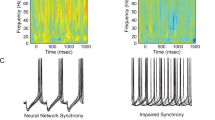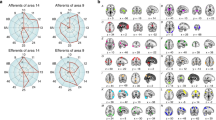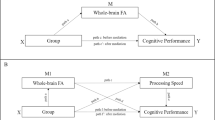Abstract
Cognitive neuropsychiatry represents a systematic and theoretically driven approach to explain clinical psychopathologies in terms of deficits to normal cognitive mechanisms. A concern with the neural substrates of impaired cognitive mechanisms links cognitive neuropsychiatry to the basic neurosciences. The emergence of cognitive neuropsychiatry in the 1990s illustrates the growing rapprochement between cognitive neuropsychology, clinical medicine and the neurosciences in addressing common questions about disorders of the mind/brain. In reviewing recent applications, we highlight how this hybrid discipline will make a distinctive contribution to the science of psychopathology.
This is a preview of subscription content, access via your institution
Access options
Subscribe to this journal
Receive 12 print issues and online access
$189.00 per year
only $15.75 per issue
Buy this article
- Purchase on Springer Link
- Instant access to full article PDF
Prices may be subject to local taxes which are calculated during checkout



Similar content being viewed by others
References
David, A. S. Cognitive neuropsychiatry? Psychol. Med. 23, 1–5 (1993).
Charlton, B. G. Cognitive neuropsychiatry and the future of diagnosis: a 'PC' model of the mind. Br. J. Psychiat. 167, 149– 153 (1995). PubMed
David, A. S. The future of diagnosis: commentary on 'Cognitive neuropsychiatry and the future of diagnosis: a 'PC' model of the mind '. Br. J. Psychiat. 167, 155–157 ( 1995).
Bentall, R. P. Brains, biases, deficits and disorders. Br. J. Psychiat. 167, 153–155 (1995).
Marshall, J. G. & Halligan, P. W. Methods in madness. Br. J. Psychiat. 167, 157– 158 (1995).
David, A. S. & Halligan, P. W. Editorial: Cognitive neuropsychiatry . Cogn. Neuropsychiat. 1, 1– 3 (1996).
Halligan, P. W. & Marshall, J. C. Method of Madness. Case Studies in Cognitive Neuropsychiatry (Psychology Press, Hove, East Sussex, 1996).
David, A. S. & Halligan, P. W. Cognitive neuropsychiatry: potential for progress. J. Neuropsychiat. Clin. Neurosci. 12, 506–510 (2000). Pubmed
Shallice, T. From Neuropsychology to Mental Structure (Cambridge Univ. Press, Cambridge, 1988).
Lishman, W. A. Organic Psychiatry. The Psychological Consequences of Cerebral Disorder 3rd edn (Blackwell Scientific Publications, Oxford & London, 1998).
James, W. The Varieties of Religious Experience (Collins, Glasgow, 1901).
Saykin, A. J. et al. Neuropsychological deficits in neuroleptic naive patients with first-episode schizophrenia. Arch. Gen. Psychiat. 51, 124–131 (1994).
McKay, A. P. et al. Semantic memory is impaired in schizophrenia. Biol. Psychiat. 39, 929–937 (1996).
Hodges, J. R. et al. The differentiation of semantic dementia and frontal lobe dementia (temporal and frontal variants of frontotemporal dementia) from early Alzheimer's disease: a comparative neuropsychological study. Neuropsychology 13, 31–40 ( 1999).
Rossell, S. L., Shapleske, J. & David, A. S. Direct and indirect semantic priming with neutral and emotional words in schizophrenia: relationship to delusions. Cogn. Neuropsychiat. 5, 271–292 (2000).
Spitzer, M. A cognitive neuroscience view of schizophrenic thought disorder. Schizophrenia Bull. 23, 29–50 (1997). PubMed
Goldberg, T. E. & Weinberger, D. R. Thought disorder in schizophrenia: a reappraisal of older formulations and an overview of some recent studies. Cogn. Neuropsychiat. 5, 1–19 (2000).
Kuperberg, G. R., McGuire, P. K. & David, A. S. Reduced sensitivity to linguistic context in schizophrenic thought disorder: evidence from on-line monitoring for words in linguistically anomalous sentences. J. Abnorm. Psychol. 107, 423–434 (1998).
Kuperberg, G. R., McGuire, P. K. & David, A. S. Sensitivity to linguistic anomalies in spoken sentences: a case study approach to understanding thought disorder in schizophrenia. Psychol. Med. 30, 345–357 (2000).
Rossell, S. L., Rabe-Hesketh, S., Shapleske, J. & David, A. S. Is semantic fluency differentially impaired in schizophrenic patients with delusions? J. Clin. Exp. Neuropsychol. 21, 629–642 (1999).
Joyce, E. M., Collinson, S. L. & Crichton, P. Verbal fluency in schizophrenia: relationship with executive function, semantic memory and clinical alogia. Psychol. Med. 26, 39–49 (1996).
Dolan, R. J., et al. Dorsolateral prefrontal cortex dysfunction in the major psychoses; symptom or disease specificity? J. Neurol. Neurosurg. Psychiat. 56, 1290–1294 ( 1993).
McGuire, P. K. & Frith, C. D. Disordered functional connectivity in schizophrenia. Psychol. Med. 26, 663–667 (1996).
Baron-Cohen, S. Mindblindness: An Essay on Autism and Theory of Mind (MIT Press, Cambridge, Massachusetts, 1997).
Frith, C. Cognitive Neuropsychology of Schizophrenia (Lawrence Erlbaum, Hove, 1992).
Mlakar, J. Jensterle, J. & Frith, C. D. Central monitoring deficiency and schizophrenic symptoms . Psychol. Med. 24, 557– 564 (1994).
Spence, S. A. et al. A PET study of voluntary movement in schizophrenic patients experiencing passivity phenomena (delusions of alien control). Brain 120, 1997–2011 ( 1997).
Blakemore, S., Smith, S.-J., Steele, R., Johnstone, E. C. & Frith, C. D. The perception of self-produced sensory stimuli in patients with auditory hallucinations and passivity experiences: evidence for a breakdown in self-monitoring. Psychol. Med. 30 , 1131 (2000).
Rauch, S. L. & Savage, C. R. Neuroimaging and neuropsychology of the striatum. Bridging basic science and clinical practice. Psychiatric Clinics of North America 20, 741– 768 (1997). PubMed
Marchetti, C. & Della Sala, S. Disentagling the alien and anarchic hand Cogn. Neuropsychiat. 3, 191– 208 (1998).
Halligan, P. W., Marshall, J. C. & Wade, D. T. Unilateral somatoparaphrenia after right hemisphere stroke: a case description. Cortex 31, 173 –182 (1995).
Halligan, P. W., Marshall, J. C. & Wade, D. T. Three arms: a case study of supernumerary phantom limb after right hemisphere stroke. J. Neurol. Neurosurg. Psychiat. 56, 159–166 ( 1993).
Halligan, P. W., & David, A. S. (Eds). Conversion hysteria: towards a cognitive neuropsychological account. Brighton: Psychology Press (2000).
Marshall, J. C., Halligan, P. W., Fink, G. R., Wade, D. T. & Frackowiak, R. S. The functional anatomy of a hysterical paralysis. Cognition 64, B1 –B8 (1997).
Bryant, R. A. & McConkey, K. M. Functional blindness: a construction of cognitive and social influences. Cogn. Neuropsychiat. 4, 227–244 (1999).
Oakley, D. Hypnosis and conversion hysteria: a unifying model. Cogn. Neuropsychiat. 4, 243–266 ( 1999).
Lloyd, G. G. & Lishman, W. A. Effects of depression on the speed of recall of pleasant and unpleasant experiences. Psychol. Med. 5, 173–180 ( 1975).
Williams, J. M. & Scott, J. Autobiographical memory in depression. Psychol. Med. 18, 689–695 (1988).
Lucchelli. F., Muggia, S. & Spinnler, H. The syndrome of pure retrograde amnesia. Cogn. Neuropsychiat. 3, 91–118 (1998).
Kopelman, M. Focal retrograde amnesia and the attribution of causality: an exceptionally critical review. Cogn. Neuropsychol. 17, 585–662. (2000).
Cutting, J. The Right Cerebral Hemisphere and Psychiatric Disorder (Oxford Univ. Press, Oxford, 1990).
Taylor, G. J. Recent developments in alexithymia theory and research. Can. J. Psychiat. 45, 134–142 ( 2000). PubMed
Sierra. M. & Berrios, G. E. Depersonalization: neurobiological perspectives. Biol. Psychiat. 44, 898– 908 (1998).
Damasio, H., Grabowski, T., Frank, R., Galaburda, A. M. & Damasio, A. R. The return of Phineas Gage: clues about the brain from the skull of a famous patient. Science. 264, 1102–1105 (1994).
Williams, J. M., Mathews, A. & MacLeod C. The emotional Stroop task and psychopathology. Psychol. Bull. 120, 3–24 (1996).
Leafhead, K. M., Young, A. W. & Szulecka, T. K. Delusions demand attention. Cogn. Neuropsychiat. 1, 5–16 (1996 ).
Freeman, D., Garety, P. A. & Phillips, M. L. An examination of hypervigilance for external threat in individuals with generalized anxiety disorder and individuals with persecutory delusions using visual scan paths. Q. J. Exp. Psychol. A 53, 549–567 (2000).
Phillips, M. L., Senior, C. & David, A. S. Perception of threat in schizophrenics with persecutory delusions: an investigation using visual scan paths. Psychol. Med. 30, 157–167 ( 2000).
Teasdale, J. D. et al. Functional MRI study of the cognitive generation of affect . Am. J. Psychiat. 156, 209– 215 (1999).
Drevets, W. C. et al. Subgenual prefrontal cortex abnormalities in mood disorders . Nature 386, 824–827 (1997).
Barnes. J. et al. Cortical activity during rotational and linear transformation . Neuropsychologia 38, 1148– 1156 (2000).
ffytche, D. H. et al. The anatomy of conscious vision: an fMRI study of visual hallucinations . Nature Neurosci. 1, 738– 742 (1998).
Adolphs, R., Tranel, D., Damasio, H. & Damasio, A. Impaired recognition of emotion in facial expressions following bilateral damage to the human amygdala . Nature 372, 669–672 (1994).
Rauch, S. L. et al. A symptom provocation study of post traumatic stress disorder using positron emission tomography and script-driven imagery. Arch. Gen. Psychiat. 53, 380–387 (1996).
Phillips, M. L. et al. A specific neural substrate for perceiving facial expressions of disgust. Nature 389, 495– 498 (1997).
Phillips, M. L. et al. A differential neural response in obsessive-compulsive patients with washing compared with checking symptoms to disgust. Psychol. Med. 30, 1037–1050 ( 2000).
Blair, R. J., Morris, J. S., Frith, C. D., Perrett, D. I. & Dolan, R. J. Dissociable neural responses to facial expressions of sadness and anger. Brain 122, 883–893 (1999).
Phillips, M. L. et al. A differential neural response to threatening and non-threatening negative facial expressions in paranoid and non-paranoid schizophrenics. Psychiatr. Res. Neuroimaging 92, 11– 31 (1999).
Fine, C. & Blair, R. J. R. The cognitive and emotional effects of amygdala damage. Neurocase 6, 435–450 (2000).
Ellis, H. D. Cognitive neuropsychiatry and delusional misidentification syndromes: an exemplary vindication of the new disciplines. Cogn. Neuropsychiat. 3, 81–90 (1998).
Ellis, H. D. & Young, A. W. Accounting for delusional misidentifications . Br. J. Psychiatry. 157, 239– 248 (1990).
Signer, S. F. Localization and lateralization in the delusion of substitution. Capgras symptom and its variants. Psychopathology 27, 168 –176 (1994).
Bruce, V. & Young, A. Understanding face recognition. Br. J. Psychol. 77, 305–327 (1986).
Breen, N., Caine, D. & Coltheart, M. Models of face recognition and delusional misidentification: a critical review. Cogn. Neuropsychol. 17, 55–72 (2000).
Bauer, R. M. Autonomic recognition of names and faces in prosopagnosia: a neuropsychological application of the Guilty Knowledge Test Neuropsychologia 22, 457–469 (1984).
Tranel, D. & Damasio, A. R. Knowledge without awareness: an autonomic index of facial recognition by prosopagnosics. Science 228, 1453–1454 ( 1985).
Ellis, H. D. et al. Reduced autonomic responses to faces in Capgras delusion. Proc. R. Soc. Lond. B 264, 1085–1092 (1997).
Hirstein, W. & Ramachandran, V. S. Capgras syndrome: a novel probe for understanding the neural representation of the identity and familiarity of persons. Proc. R. Soc. Lond. B 264, 437 –444 (1997).
Tranel, D., Damasio, A. R. & Damasio, H. Double dissociation between overt and covert recognition . J. Cogn. Neurosci. 7, 425– 432 (1995).
Stone, T. & Young, A. W. Delusions and brain injury; the philosophy and psychology of belief. Mind and Language 12, 327–364, 1997.
Kemp, R., Chua, S., McKenna, P. & David, A. Reasoning in delusions: an empirical study. Br. J. Psychiat. 170, 398–405 (1997). PubMed
Garety, P. A. & Freeman, D. Cognitive approaches to delusions: a critical review of theories and evidence. Br. J. Clin. Psychol. 38, 113–154 ( 2000). PubMed
Ellis, H. D., Young, A. W., Quayle, A. H. & de Pauw K. W. Response to “Misidentification syndromes and cognitive neuropsychiatry” . Trends Cogn. Sci. 1, 158 ( 1997).
Slade, P. & Bentall, R. Sensory Deception: A Scientific Analysis of Hallucination (London, Croom Helmm, 1988 ).
Dierks, T. et al. Activation of Heschl's gyrus during auditory hallucinations . Neuron 22, 615–621 (1999).
David, A. S. et al. Auditory hallucinations inhibit exogenous activation of auditory association cortex. Neuroreport 7, 932– 936 (1996).
Woodruff, P. W. R. et al. Auditory hallucinations and the temporal cortical response to speech in schizophrenia: a functional magnetic resonance imaging study. Am. J. Psychiat. 154, 1676– 1682 (1997).
Shergill. S. S., Brammer, M. J., Williams, S. C., Murray, R. M. & McGuire, P. K. Mapping auditory hallucinations in schizophrenia using functional magnetic resonance imaging. Arch. Gen. Psychiat. 57, 1033–1038 (2000).
Evans, C. L., McGuire, P. K. & David, A. S. Is auditory imagery defective in patients with auditory hallucinations? Psychol. Med. 30, 137– 148 (2000).
David, A. S. & Lucas, P. A. Auditory–verbal hallucinations and the phonological loop: a cognitive neuropsychological study. Br. J. Clin. Psychol. 32, 431–441 (1993).
David, A. S. in The Neuropsychology of Schizophrenia (eds David, A. S. & Cutting, J. C.) (Lawrence Erlbaum, Hove, 1994).
Brébion, G. et al. Positive symptomatology and source-monitoring failure in schizophrenia — an analysis of symptom-specific effects. Psychiat. Res. 95, 119–131 ( 2000). PubMed
Goldberg, T. E., Gold, J. M., Coppola, R. & Weinberger, D. R. Unnatural practices, unspeakable actions: a study of delayed auditory feedback in schizophrenia . Am. J. Psychiat. 154, 858– 860 (1997).
McGuire, P. K. et al. Abnormal monitoring of inner speech: a physiological basis for auditory hallucinations. Lancet 346 , 596–600 (1995).
Shergill, S. S., Bullmore, E., Simmons, A., Murray, R. & McGuire, P. Functional anatomy of auditory verbal imagery in schizophrenic patients with auditory hallucinations. Am. J. Psychiat. 157, 1691–1693 (2000).
Amador, X. F. & David, A. S. (eds) Insight and psychosis (Oxford Univ. Press, New York, 1998).
Hoffman, R. E. Language processing and hallucinated “voices”: insights from transcranial magnetic stimulation. Cogn. Neuropsychiat. 6, 1–6 (2001).
Ellis, H. D. & Lewis, M. B. Capgras delusion: a window on face recognition. Trends Cogn. Sci. (in the press).
Acknowledgements
PWH acknowledges the support of The Medical Research Council. We thank Sukhi Shergill for permission to use Figure 3.
Author information
Authors and Affiliations
Related links
Related links
FURTHER INFORMATION
ENCYCLOPEDIA OF LIFE SCIENCES
Glossary
- ALIEN AND ANARCHIC HAND SYNDROMES
-
Neurological conditions in which the patient denies ownership or is not always in control of his/her own hand.
- CONDITIONAL REASONING
-
A form of inferential reasoning that consists of two elements: 1) a conditional clause stating a relationship between two things and 2) some evidence pertaining to the conditional clause. The task is to determine whether the evidence supports, refutes, or is irrelevant to the stated relationship
- COTARD'S SYNDROME
-
A severe type of depression with nihilistic delusions of death.
- DSM-IV
-
Diagnostic and statistical manual of mental disorders, fourth edition.
- EPISODIC MEMORY
-
The recollection of events in an autobiographical context.
- ICD-10
-
The International Statistical Classification of Diseases and Related Health Problems, tenth revision.
- NEGATIVE-SYNDROME SCHIZOPHRENIA
-
Schizophrenia characterized by the absence of normal behaviours such as communicative speech and emotional reactivity.
- NOSOLOGY
-
Branch of medicine that deals with classification of diseases.
- PHONOLOGICAL FLUENCY TASK
-
In this task, people are required to generate or identify words that begin with a specific letter, independent of their meaning.
- PROSOPAGNOSIA
-
Inability to visually recognise faces that were previously familiar.
- PSYCHOGENIC FUGUE
-
Condition in which the patient often assumes a new identity, and suddenly and unexpectedly travels away from his/her usual environment. It is commonly accompanied by an inability to recall the past.
- SEMANTIC FLUENCY TASK
-
In this task, people are required to generate or identify words that belong to a specific category.
- SEMANTIC MEMORY
-
The recollection of factual information independent of the specific episodes in which that information was acquired.
- SEMANTIC PRIMING
-
A quickening in reaction time for responding to words that are preceded by a semantically related 'priming stimulus'.
- SOMATOPARAPHRENIA
-
Syndrome in which patients hold delusional beliefs about parts of their body.
- STROOP COLOUR–WORD INTERFERENCE TEST
-
The test takes advantage of our ability to read words faster than we can name colours. If a word is printed or displayed in a colour different from the colour it actually names, the time it takes to read the word will be shorter than the time needed to name its colour. For example, if the word 'green' is written in blue ink, we will say the word 'green' faster than 'blue'.
- SYLLOGISTIC REASONING
-
A form of inferential reasoning based on a self-evident and irrefutable truth that ends in a necessarily true and therefore irrefutable conclusion.
- TOURETTE'S SYNDROME
-
Neurological disorder characterized by intermittent, brief involuntary movements or sounds that are called tics. It is thought to be caused by abnormalities of the basal ganglia.
- TRANSCRANIAL MAGNETIC STIMULATION
-
A technique use to induced a transient interrruption of normal brain activity in a relatively restricted area of the brain. It is based on the generation of a strong magnetic field near the area of interest which, if changed rapidly enough, it will induce an electric field sufficient to stimulate neurons.
Rights and permissions
About this article
Cite this article
Halligan, P., David, A. Cognitive neuropsychiatry: towards a scientific psychopathology. Nat Rev Neurosci 2, 209–215 (2001). https://doi.org/10.1038/35058586
Issue Date:
DOI: https://doi.org/10.1038/35058586
This article is cited by
-
Using dimensionality-reduction techniques to understand the organization of psychotic symptoms in persistent psychotic illness and first episode psychosis
Scientific Reports (2023)
-
Introspection and Belief: Failures of Introspective Belief Formation
Review of Philosophy and Psychology (2023)
-
All roads lead to the motor cortex: psychomotor mechanisms and their biochemical modulation in psychiatric disorders
Molecular Psychiatry (2021)
-
Action, affordances, and anorexia: body representation and basic cognition
Synthese (2018)



